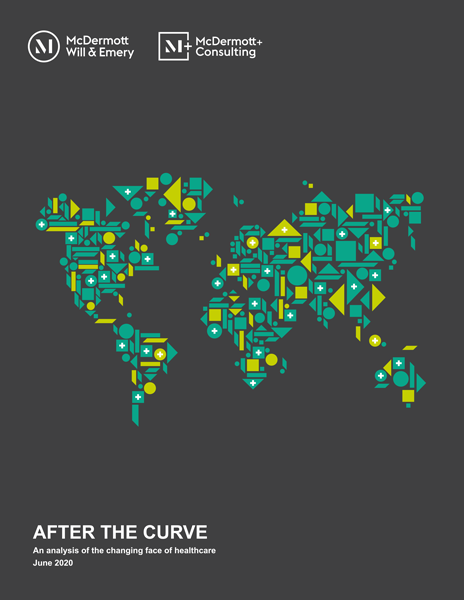After The Curve:
An Analysis of the Changing Face of Healthcare
In the same way that the events of September 11, 2001, suddenly and permanently changed the way we travel, the current Coronavirus (COVID-19) pandemic is suddenly and permanently changing the way we deliver, consume and pay for healthcare services in the United States.
Over the last few decades, we have struggled to find policy or market-based solutions to increase clinical quality while also reducing overall costs. Now, the COVID-19 pandemic has exposed additional systemic weaknesses in our fragmented, episodic approach to healthcare delivery and historical undervaluing of preventative and public health measures.
The pandemic has also opened doors to innovation, however, as industry participants mobilize crisis resources;
adjust operations for enhanced screening, sanitization and social distancing measures; and harness telehealth capabilities to deliver healthcare remotely.
For as much talk as there has been about “innovative disruption” in recent years, Mother Nature has proven to be a more effective disruptor and agent of change.
As communities begin to reopen, COVID-19 remains a virulent threat. While scientists race to develop a vaccine, most acknowledge that a “return to normalcy” will be a long process. Indeed, some things will never again be the way they once were. In the following pages, we highlight the challenges and opportunities that healthcare operators and investors should consider as the industry finds its way to a new normal.
Each episode explores the unique challenges and opportunities facing different health industry sectors as we transition to a “new normal” in the wake of COVID-19.
On this episode of the After the Curve podcast, Stephen Bernstein and Lisa Mazur discuss the future of telehealth and use of digital tools to speed up care delivery and to improve outcomes in the wake of COVID-19, as well as the vital role of data readiness in reshaping the healthcare system.
On this episode of the After the Curve podcast, Eric Zimmerman, Mara McDermott and Jessica Roth from
McDermott+Consulting join us to discuss how the pandemic has changed the conversation leading up to the November presidential election and how key policy issues will evolve in the months and years to come.
On this episode of the After the Curve podcast, Stephen Bernstein and Kristian Werling discuss the most promising areas of drug discovery and device development that are emerging from the pandemic and the outlook for the industry in a post-COVID-19 world.
On this episode of the After the Curve podcast, Sandy DiVarco and Emily Cook discuss the impact of the pandemic on healthcare provider organizations, and how provider organizations can innovate their business models and care delivery to adapt and thrive in a post-COVID-19 world.
Focus on Regulatory and Enforcement
On this episode of the After the Curve podcast, Monica Wallace and Emily Jane Cook discuss how the health regulatory landscape and enforcement priorities may shift in both the short and long term as we transition to the post-COVID-19 era.
On this episode of the After the Curve podcast, Jed Spielman and Kevin Miller discuss how the COVID-19 pandemic is affecting healthcare transactions today, as well as the outlook for the healthcare deal landscape post-COVID-19.
Focus on Health Insurance and Coverage
On this episode of the After the Curve podcast, Kate McDonald and Ankur Goel discuss how the COVID-19 pandemic may shift the healthcare coverage and payment landscape as well as how it may boost integration among payors and providers.
Telehealth adoption rates exploded in recent months as the federal government knocked down long-standing obstacles to adoption and healthcare providers leveraged the solution to care for patients outside the office. The post-Coronavirus (COVID-19) landscape is unclear, but regulators have signaled that many of the changes made during the emergency period will become permanent. This likely means momentum will continue, particularly with an increased use of remote monitoring, clinical decision support software that brings real-time data into the hands of clinicians and consumers, and supplemental patient engagement apps and tools that move beyond an episodic care delivery model to an enhanced continuum of care. However, these innovations depend upon the availability of complete, structured data that can move seamlessly between healthcare practitioners with the consumer at the center.
AFTER THE CURVE PODCAST:
FOCUS ON DIGITAL HEALTH
On this episode of the After the Curve podcast, Stephen Bernstein and Lisa Mazur discuss the future of telehealth and use of digital tools to speed up care delivery and to improve outcomes in the wake of COVID-19, as well as the vital role of data readiness in reshaping the healthcare system.
Current regulatory changes have spurred additional innovation, including the integration of artificial intelligence systems into telehealth services, greater use of telehealth services in certain care settings, and more support overall from legislators and their constituents clearly seeing the benefits.
New tools will include methodologies to aggregate data, make that data smarter and adaptive to particular patients and patent conditions, then place it in the hands of both clinicians and patients to form a partnership for care delivery and management.
The future for data standardization is now; building fluid pathways for health information will reduce duplicative testing and enable enhanced data analytics for use in treatment, population health and research.
Provider organizations (especially hospitals and health systems) should take a leadership role in working with government authorities to create new, more effective public health crisis playbooks.
In light of steep economic challenges, hospitals and health systems may have an increased interest in consolidation. These entities should start evaluating their markets now, so that they are prepared to engage in traditional transactions or more innovative structures as the health industry recovers.
There is need to adapt to changes in healthcare delivery. Provider organizations should be mindful of the other disruptions and opportunities highlighted by the COVID-19 pandemic—notably, new sanitization and social distancing requirements; potential shifts in both workforce and consumer preferences; and the rapid, transformative shift to telehealth and associated opportunities for growth.
The COVID-19 crisis has highlighted the foundational role of hospitals, health systems, physicians, nurses and other care providers play in the healthcare system. This leadership role presented new challenges and opportunities for all who are on the front lines of care delivery, several of which will require them to rethink their business and delivery of care models. In order to be prepared for a second wave they’ll need to act quickly.
Health Insurance
and Coverage
The COVID-19 pandemic may lead to lasting shifts in coverage and payment for healthcare as well as the integration of payors and providers. The expansion of telehealth capabilities across the provider market and widespread consumer acceptance create longer-term opportunities for health insurers to permanently enhance coverage and adoption of telehealth services. Payors are also increasingly seeking to add other digital tools, such as remote monitoring and healthcare apps, to the benefits they offer to members. The experience of physical distancing likely will accelerate innovation in both coverage and adoption of such technologies, even as the regulatory landscape continues to evolve. The current crisis has also resulted in widespread attention on the US healthcare system, which may further mobilize political forces focused on expanding the government’s role in health coverage.
Telehealth offers several potential benefits for insurers, often moving care to a more cost-effective setting and improving geographic access to specialist services, but the evolving regulatory landscape will continue to shape coverage policies and contractual relationships.
The current environment may give rise to unexpected partnerships and longer-term collaborations between payors and unexpected partners, such as drug manufacturers, diagnostic labs and digital health companies.
If the economy remains affected by the pandemic or is slow to recover, increased payor interest in subsidized coverage may prove to be a broader trend over the next few years.
Future regulatory requirements, such as pandemic plans and patient distancing, may increase the burden on providers.
New enforcement actions and potential litigation may focus on compliance with COVID-19-related waivers and interim final rules, various advanced payment and relief fund terms and conditions and payment compliance measures, and cross-state practice issues.
Internal compliance activities should include tracking and planning for the unwinding of waivers, tracking and documenting billing and general compliance with applicable waivers and payment and relief fund requirements, and engaging in future emergency planning and supply chain contracting and validation activities.
Regulatory and Enforcement
The biggest regulatory opportunity for healthcare providers following the initial influx of COVID-19 is the potential for certain regulatory flexibilities that were put in place during the public health emergency to become permanent. Directives relaxing Medicare requirements for telehealth services and remote patient monitoring in particular may remain in place or even expand further as stakeholders call for such emergency regulatory changes to continue. Similarly, Medicare hospital Conditions of Participation (CoPs) may see permanent adjustments if certain CoPs are deemed unnecessary for proper oversight or patient safety as demonstrated during the pandemic. Conversely, the biggest challenge for healthcare providers will be tracking the transition of the regulatory landscape post-public health emergency, including the status of temporary waivers and guidance, potential new pandemic preparedness or supply chain-focused regulations, and COVID-19-related enforcement opportunities.
The 2020 election will occur against the backdrop of the United States’ recovery from a near-nationwide shutdown in response to COVID-19. Congress and the administration are grappling with solutions for high levels of unemployment, loss of medical coverage and the challenges facing businesses, including healthcare providers, as they struggle to reopen. Healthcare coverage and access were central issues in the 2020 presidential campaign before COVID-19, and they will continue to be focal points in the months and years to come. We anticipate a shift in regulatory and congressional priorities, in the immediate term.
The presidential election is the most significant factor shaping the future of healthcare policy, and the candidates offer very different visions. While former Vice President Joe Biden is committed to building on the Affordable Care Act, President Donald Trump’s policies have chipped away at the law and taken steps to fully repeal it.
Transparency is likely to continue as a major focus of the regulatory agenda, while other issues such as drug pricing reform are likely to move out of focus in the near term.
In Congress, both parties may attempt to revisit pre-pandemic policy issues such as surprise billing. Other issues, such as prescription drug prices, seem unlikely to arise in the short term unless COVID-19 vaccines and treatments catapult pricing back to the forefront of national attention.
Despite global economic uncertainty, the health, technology and life sciences sectors have converged with the investment community to innovate, collaborate and respond to unmet needs caused by the pandemic, like those for successful tests, treatments and vaccines.
The life sciences sector has been economically resilient during the turbulence of the pandemic, with biotech companies awash in more cash than ever before, record numbers of strategic collaborations and partnerships, and continued strong IPO activity.
As the world recognized the dominance China plays in the global supply of active pharmaceutical ingredients and their chemical raw material, the US has launched efforts to rebalance the supply chain. Similarly, exponential growth in the use of artificial intelligence to further speed drug discovery and development can be expected.
The speed in which the biotech sector has pivoted toward innovation in the face of the global pandemic is unprecedented. As governments, health organizations and public health officials scrambled to mobilize and coordinate a coherent response to the global pandemic, with varying degrees of success, the private sector life sciences industry took a much more nimble approach. Time will tell if it is sustainable or has instead created its own set of risks that outweigh the benefits of eventual results. Moreover, as with the last recession, the biotech sector appears to be less sensitive to macroeconomic swings, which could mean less disruption to the drugs and therapies currently under clinical development. And as nearly every major pharmaceutical company worldwide is racing to develop effective therapeutics and vaccines to combat COVID-19, regulators have established several options to loosen restrictions and simplify approval pathways.
Although transaction volume in the healthcare industry has reached all-time highs in recent years, the sudden and unanticipated cash flow and operational disruptions resulting from the COVID-19 pandemic have slowed most M&A and other transactional efforts for both strategic and financial investors. Parties have struggled to agree on valuation adjustments for the pandemic impact, and sellers have been reticent to bring new platforms to market.
However, robust investor appetite persists, particularly among private equity funds sitting on considerable dry powder for new investment even prior to the pandemic. Credit markets also remain favorable for leveraged buy-outs, with current monetary policy promising low interest rates for debt financing in the near term.
A surge in deal activity may be coming. Already investors are exploring ways to beat the curve by underwriting some uncertainty in their valuation assumptions and correspondingly exploring options to hedge that risk.
Smart investors will not simply assume a “return to normal,” but will rather endeavor to evaluate what “new normal” will emerge for the target business.
The pandemic has exposed gaps in the process of healthcare delivery and opened new opportunities that can be addressed when participants across health, life sciences technology and other subsectors join forces. Many investors are already exploring business combinations, joint ventures and other innovative transactions to capitalize on these opportunities and to address the new set of challenges facing both providers and patients to deliver and receive care safely and effectively.







